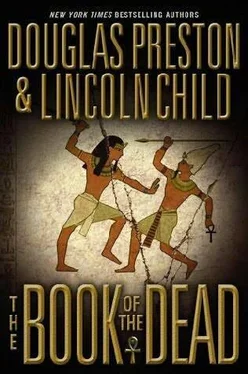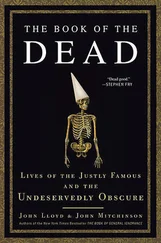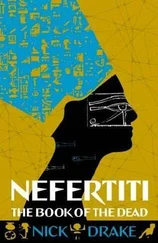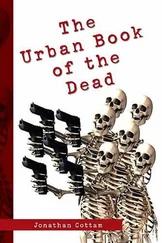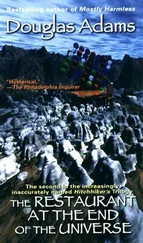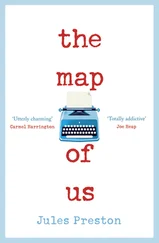March 22, 1938
Signed: Lucien P. Strawbridge
Curator of Egyptology
Nora turned this card over in surprise. Secure Storage? That must be what was now known as the Secure Area, where the museum kept its most valuable artifacts. What inside this file could have merited being locked away?
She replaced the piece of cardboard and put the file aside, making a mental note to follow up on this later. There was just one final bundle to go. Unsealing it, Nora found it to be full of correspondence and notes on the building of the pedestrian tunnel connecting the IND line subway station to the museum.
The correspondence was voluminous. As Nora read through it, she began to realize that the story the museum told-that the tomb had been sealed off because of the construction of the tunnel-was not exactly true. The truth, in fact, was just the opposite: the city wanted to route the pedestrian walkway from the front of the station well past the entrance of the tomb-a quicker and cheaper alternative. But for some reason, the museum wished to situate the tunnel toward the far end of the station. Then they argued that the new route would cut off the tomb’s entrance and force its closure. It seemed as if the museum wanted to force the closure of the tomb.
She read on. Toward the end of the file, she found a handwritten note, from the same Lucien P. Strawbridge who’d placed the earlier file in Secure Storage, scribbled on a memo from a New York City official asking why the museum wanted the pedestrian walkway in that particular location, given the extra costs involved.
The marginalia read:
Tell him anything. I want that tomb closed. Let us not miss our last, best chance to rid ourselves of this damnable problem.
L. P. Strawbridge
Damnable problem? Nora wondered just what kind of problem Strawbridge was referring to. She flipped through the file again, but there didn’t seem to be a problem connected with the tomb, beyond the annoyance of the Bey of Bolbassa’s comments and the crank letters they had generated.
The problem, she decided, must be in the file in Secure Storage. In the end, it didn’t seem relevant, and she had run out of time. When she had time, she might look into it. As it was, if she didn’t get started on her report, she’d never make dinner with Bill.
She pulled her laptop toward her, opened a new file, and began typing.
The following day, Captain of Homicide Laura Hayward showed her ID and was deferentially ushered into the office of Jack Manetti, head of security for the New York Museum of Natural History. Hayward liked the fact that, in a museum where the administration seemed overly concerned with status, the head of security had chosen for himself a small, windowless office in the back of the security pool, and had furnished it with utterly functional metal desks and chairs. It said something positive about Manetti-at least she hoped it did.
Manetti was clearly not happy to see her, but he made an attempt at courtesy, offering her a chair and a cup of coffee, which she declined.
“I’m here on the Green assault,” she said. “I wonder if you’d be willing to accompany me to the Sacred Images show so we can run through a few additional questions I have about ingress and egress, access, security.”
“But we’ve been all over that, weeks ago. I thought the investigation was complete.”
“My investigation isn’t complete yet, Mr. Manetti.”
Manetti licked his lips. “Did you go through the office of the director? We’re supposed to coordinate all law enforcement-”
She cut him off and stood up, growing irritated. “I don’t have the time, and neither do you. Let’s go.”
She followed the security director through a labyrinth of corridors and dusty halls, arriving at last at the exhibit entrance. The museum was still open and the security doors hooked back, but the exhibit itself was almost deserted.
“Let’s begin here,” said Hayward. “I’ve been going over the setup again and again, and there are a few things I just don’t get. The perp had to enter the hall through this door, am I correct?”
“Yes.”
“The door at the far end could be opened only from the inside, not from the outside. Right?”
“That’s right.”
“And the security system was supposed to automatically keep a log of all who came and went, because each magnetic card key is coded with the name of the owner.”
Manetti nodded.
“But the system registered no entry other than Margo Green. The perp then stole her card and used it to leave by the rear exit.”
“That’s the assumption.”
“Green could have entered and left this door hooked open.”
“No. First, that would have been against the rules. Second, the system registered that she didn’t do that. A few seconds after she entered, the door reengaged. We had an electronic log to that effect.”
“So the perp must have been waiting in the hall, hiding, from the time it closed to visitors-five o’clock-until the time of the assault, two A.M.”
Manetti nodded.
“Or else the perp managed to get around the security system.”
“We think that’s highly improbable.”
“But I think it’s almost certain. I’ve been through this hall a dozen times since the assault. There’s no place for the perp to have hidden.”
“It was under construction. Stuff was all over the place.”
“It was two days from opening. It was almost finished.”
“The security system is foolproof.”
“Like the Diamond Hall. Right?”
She watched Manetti’s lips tighten and felt a pang. This wasn’t her style. She was becoming a bitch, and she didn’t like it.
“Thank you, Mr. Manetti,” she said. “I’d like to make another pass through the hall, if you don’t mind.”
“Be our guest.”
“I’ll be in touch.”
Manetti disappeared and Hayward took a thoughtful turn around the room where Green had been attacked, picturing, yet again, each step of the assault in a kind of mental stop-motion. She tried to shut out the little voice in her head that said this was a wild-goose chase; that she wasn’t likely to find anything of value here weeks after the attack, after a hundred thousand people had walked through; that she was doing this for all the wrong reasons; that she should just get on with her life and career while she still could.
She took another turn around the room, the little voice disappearing under the rap of her heels against the floor. As she came to the side of the case where the spot of blood had been found, she saw a crouched, dark-suited figure moving toward her from behind the case, ready to spring out.
She pulled out her weapon, drew down on the figure. “You! Freeze! NYPD!”
The person leaped up with a gargled shout, arms windmilling, an unruly cowlick of hair bobbing. Hayward recognized him as William Smithback, the Times city desk reporter.
“Don’t shoot!” the journalist cried. “I was just, you know, looking around! Jesus, you’re scaring the hell out of me with that thing!”
Hayward holstered her weapon, feeling sheepish. “Sorry. I’m a bit on edge.”
Smithback squinted. “You’re Captain Hayward, isn’t that right?”
She nodded.
“I’m covering the Pendergast case for the Times.”
“I’m aware of that.”
“Good. In fact, I’ve been meaning to talk to you.”
She glanced at her watch. “I’m very busy. Make an appointment through my office.”
“I already tried that. You don’t speak to the press.”
“That’s right.” She gave him a stern look and took a step forward, but he didn’t step aside to let her pass.
Читать дальше
